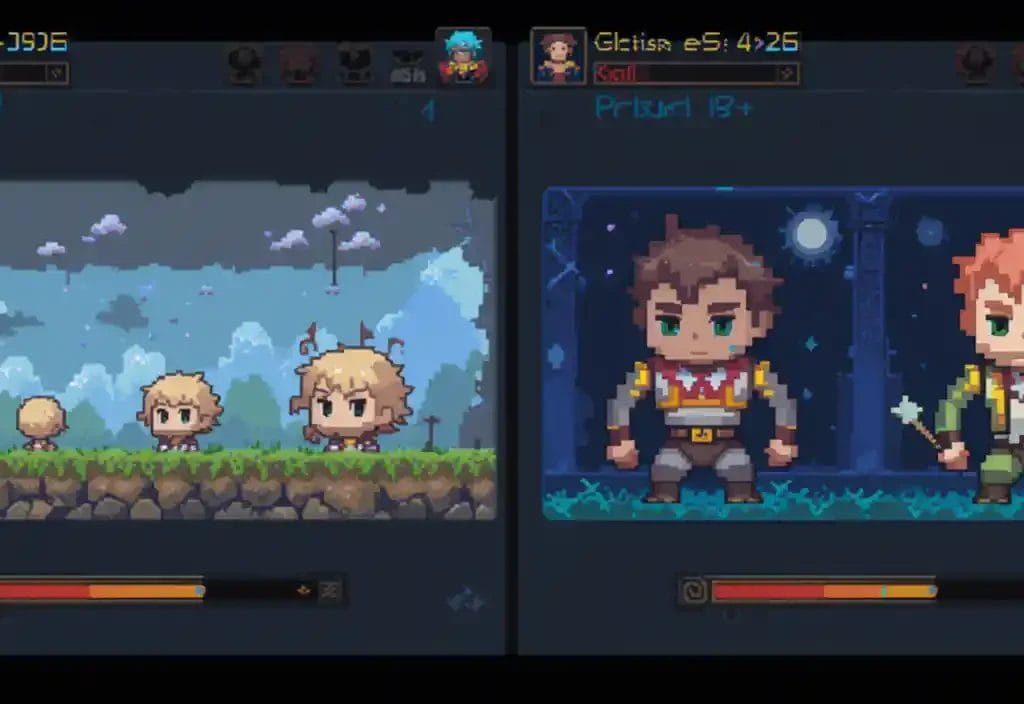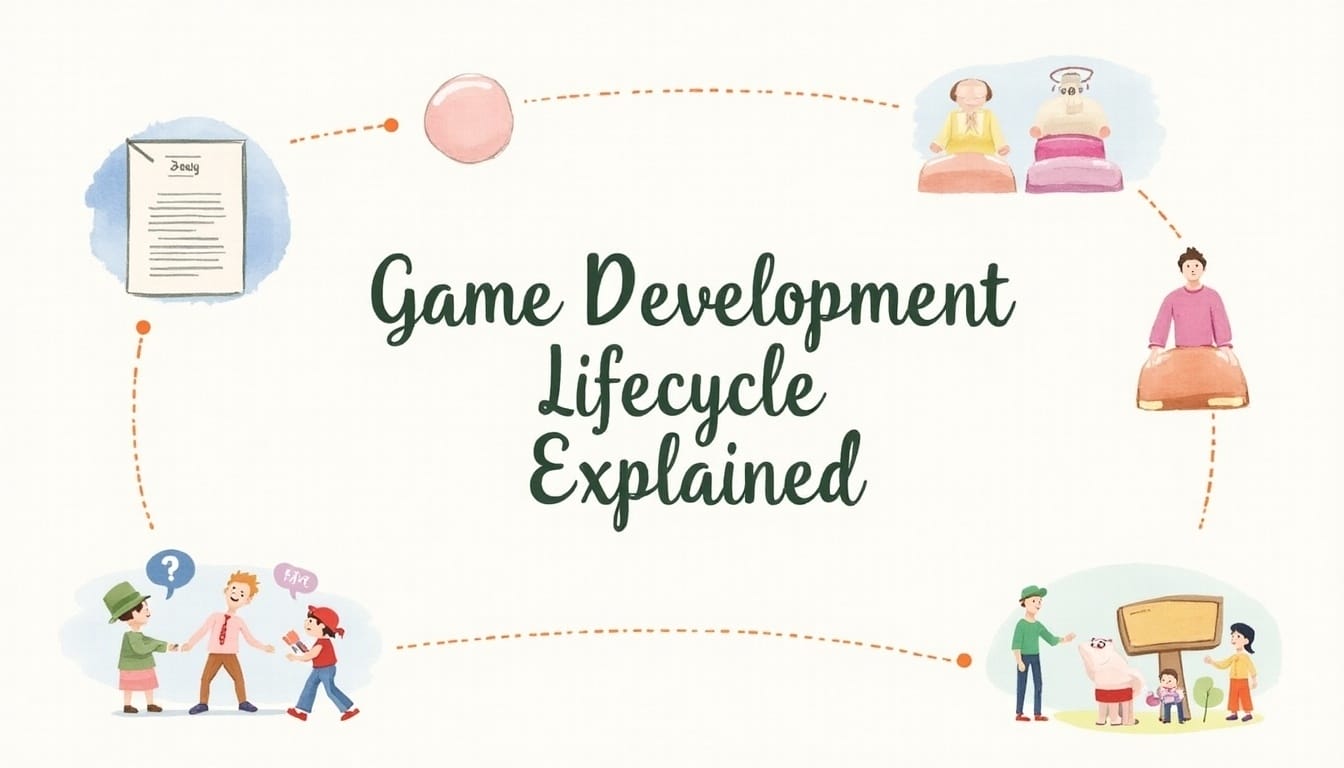What is the Game development Lifefcycle and why it matters?
The game development lifecycle consists of various stages that transform an idea into a playable product. It starts with idea generation and conceptualization, ensuring the concept resonates with the target audience. Next is planning, where the vision, objectives, and scope are defined along with creating a Game Design Document (GDD) to guide development. Following this is pre-production, which involves character designs and gameplay mechanics; prototypes are made to check feasibility. The production phase is lengthy, bringing together programmers and artists who create assets based on the GDD while continually testing for quality assurance. Once ready for launch, games enter post-release support to maintain player engagement through updates and new content.

1. Idea Generation and Conceptualization
The journey of game development begins with a spark of creativity—an idea that is both unique and engaging. This initial phase is crucial as it lays the foundation for the entire project. Developers and designers often engage in brainstorming sessions, where they explore various concepts and themes that resonate with their target audience. It’s essential to conduct thorough research to understand market trends and player preferences, enabling the development team to refine their ideas. For instance, a game about survival in a post-apocalyptic world may stand out if it includes innovative mechanics or a gripping narrative that sets it apart from existing titles. The goal during this phase is to identify a game concept that not only captivates players but also offers something distinct in a crowded market.

Market Analysis
Before diving into development, teams must conduct thorough market research to:
- Identify market gaps and opportunities
- Analyze competitor games and their unique selling points
- Understand current gaming trends and player preferences
- Define the target audience demographics and preferences
Creative Development
The conceptualization phase focuses on establishing:
- Core game concept and unique value proposition
- Primary gameplay mechanics and features
- Initial story elements and world-building concepts
- Art direction and visual style guidelines
- Technical feasibility assessment
2. Planning the Game Development Process
Planning is a critical phase in the game development lifecycle that sets the foundation for the entire project. During this stage, developers define the game concept, vision, and mission statement. They also establish clear objectives that will guide the development team throughout the process. Understanding the target audience is crucial, as it helps shape the game to meet player expectations and preferences. Additionally, determining the project scope, budget, and timeline is essential to ensure that resources are allocated efficiently.A key deliverable of this phase is the Game Design Document (GDD). This document serves as the blueprint for the game, detailing core mechanics, gameplay features, storyline, and art style. For instance, if the game is an action-adventure title, the GDD would outline the combat system, level design, and character abilities, ensuring everyone on the team is aligned with the creative vision.
Effective planning also involves identifying potential risks and challenges that may arise during development. By anticipating these issues early on, teams can devise strategies to mitigate them, such as adjusting timelines or reallocating resources as needed. Collaboration among team members is crucial during this phase, as input from different disciplines—such as design, art, and programming—can lead to a more cohesive and well-rounded game concept.
- Define the game’s target audience
- Establish the budget and resources
- Create a project timeline with milestones
- Identify team roles and responsibilities
- Conduct competitor analysis
- Outline the game design document (GDD)
- Set performance indicators for success
3. Pre-Production Phase Overview (20% of Development Timeline)
The pre-production phase is crucial for setting the foundation of the game development process. During this stage, developers expand on the initial game concept, creating detailed storylines, character designs, and gameplay mechanics. This is where the vision starts to take shape, and it often involves creating concept art, storyboards, and sketches to visualize the game’s aesthetic. For instance, a game inspired by a fantasy world might include sketches of its characters, creatures, and environments to evoke the intended atmosphere.
Another significant aspect of pre-production is prototyping. Developers create simple versions of gameplay mechanics to test their feasibility and ensure they align with the game’s vision. This could involve designing a basic level to assess how players interact with the environment or mechanics. The insights gained from these prototypes help refine the game before it enters production.
Team Formation
The initial pre-production team typically consists of:
- Producer/Project Manager
- Lead Game Designer
- Technical Director
- Art Director
- Core Programmers
- Concept Artists
Documentation Development
Game Design Document (GDD)
Throughout pre-production, the Game Design Document (GDD) serves as a living document that evolves alongside the project. It captures the core mechanics, story, art style, and objectives, ensuring that everyone involved has a clear understanding of the game’s direction. By finalizing the GDD during this phase, teams can mitigate risks and set realistic expectations for the production phase.
The GDD serves as the project’s foundation, including:
- Detailed gameplay mechanics
- Character and world descriptions
- Technical specifications
- Art style guides
- Monetization strategy
- Development milestones
Prototyping
Prototype development focuses on:
- Core gameplay mechanics validation
- Technical architecture testing
- Art style verification
- Initial performance benchmarking

4. The Production Stage: Bringing Your Game to Life
The production stage is the heart of game development, where ideas transform into a playable reality. This phase is characterized by the collaboration of programmers, artists, and designers, all working together to bring the game to life based on the Game Design Document (GDD). Each team member has specific tasks: programmers write the code that underpins the game’s mechanics, artists create visual assets like characters and environments, and designers develop engaging gameplay and story elements.
Throughout production, milestones are set to track progress. These include creating a first playable version, known as a prototype, a vertical slice that showcases a portion of the game, and progressing through alpha and beta versions. Each of these stages involves rigorous testing and feedback, allowing the team to refine gameplay and fix any bugs. For instance, during the alpha phase, the game may still have many rough edges, but it’s vital for testing core mechanics and ensuring that the game is enjoyable.
As the production stage advances, continuous testing becomes essential. This iterative process allows developers to gather feedback, identify issues, and implement improvements, ensuring that the final product meets player expectations. With each iteration, the game evolves closer to its final form, ready for the next stages of testing and eventual launch.

The production stage represents the heart of game development, where creative visions transform into playable experiences. This phase typically consumes the largest portion of development time, often spanning one to four years depending on the project’s scope. During this crucial period, teams grow to their largest size as they tackle the complex challenge of building a cohesive game experience.
Game Development Lifecycle: Milestones
First Playable
The journey begins with creating the first playable version of your game. Unlike the basic prototype from pre-production, this milestone implements core gameplay mechanics with initial artwork, even if temporary. For example, when developing “Stardew Valley,” creator Eric Barone’s first playable version included basic farming mechanics and character movement, using simple placeholder sprites that would later evolve into the game’s distinctive pixel art style.
This stage focuses on validating that the fundamental gameplay loop is engaging. Teams typically ask questions like: Does the core mechanic feel satisfying? Is the basic control scheme intuitive? Can players understand the game’s primary objectives? The answers help shape subsequent development priorities.
Vertical Slice
The vertical slice represents a fully polished section of gameplay that demonstrates the game’s potential. Think of it as a proof of concept that showcases your game’s unique features, visual style, and technical capabilities. This milestone often serves multiple purposes: it helps secure additional funding, validates the production pipeline, and provides marketing materials for early promotion.
For instance, the vertical slice for “God of War” (2018) included a complete combat encounter that demonstrated the new over-the-shoulder camera perspective and father-son dynamics between Kratos and Atreus. This slice proved crucial in convincing stakeholders that the dramatic shift in gameplay perspective would work for the franchise.
Alpha Stage
Reaching alpha is a significant milestone marking the implementation of all major features, though they may still need refinement. At this stage, the game is “feature complete” but not necessarily “content complete.” Teams can now play through the entire game, albeit with some placeholder assets and rough edges.
During alpha, development focuses on:
- Implementing all planned features and mechanics
- Integrating primary content and assets
- Establishing core systems like save/load functionality
- Initial performance optimization
- Basic bug fixing and system stability
Beta Stage
The beta stage represents a content-complete version of the game where all assets are in their final or near-final state. This phase focuses heavily on refinement, optimization, and bug fixing. Quality Assurance teams expand their testing efforts, often bringing in external testers to provide fresh perspectives.
Key activities during beta include:
- Comprehensive bug fixing and tracking
- Performance optimization across all target platforms
- Balancing gameplay elements
- Polishing user interface and experience
- Preparing for platform certification requirements
Team Dynamics and Scaling
Production requires careful orchestration of multiple specialized teams working in parallel. A typical AAA game project might scale up to hundreds of developers during peak production, while indie games might maintain a much smaller, more versatile team.
Core Development Team
The programming team builds and refines game systems, from core mechanics to technical features like save systems and optimization. They work closely with designers to implement gameplay features and with artists to ensure assets work efficiently within the game’s technical constraints.
Art Production Pipeline
Artists begin creating final assets following the approved art direction. This includes:
- Character modeling and animation
- Environment creation
- Visual effects
- UI design and implementation
- Lighting and post-processing effects
Design Implementation
Designers work on multiple fronts:
- Level designers craft and iterate on game spaces
- Systems designers balance and refine gameplay mechanics
- Combat designers (in action games) create and tune enemy encounters
- Quest designers develop mission structures and narrative delivery
Technical Implementation
Modern game production requires robust technical infrastructure to handle the complexity of development. Version control systems track changes across thousands of assets and code files. Build systems compile and package the game for testing multiple times per day. Automated testing helps catch technical issues early.
Pipeline Optimization
Successful production relies on efficient workflows that allow rapid iteration. Teams implement tools and systems to streamline common tasks:
- Custom level editors for rapid environment creation
- Asset management systems for tracking thousands of game elements
- Automated build and test systems
- Real-time collaboration tools for remote teams
Quality Control Systems
Throughout production, various systems ensure quality:
- Continuous integration pipelines catch technical issues early
- Automated performance testing identifies optimization needs
- Regular playtesting sessions gather gameplay feedback
- Bug tracking systems prioritize and manage issue resolution
Risk Management
Production inevitably faces challenges that require proactive management:
- Technical obstacles that require creative solutions
- Resource constraints that demand priority adjustments
- Schedule pressures that need careful balancing
- Team coordination challenges as the project scales
Successful productions maintain flexibility while staying focused on core objectives. Regular evaluations help teams adjust plans without losing sight of the game’s essential vision.
5. Importance of Testing and Quality Assurance
Testing and quality assurance (QA) play a vital role in the game development lifecycle. This phase is essential to ensure that the game is free of bugs and runs smoothly, providing players with an enjoyable experience. Rigorous testing helps identify technical issues that could hinder gameplay, such as glitches, crashes, or unresponsive controls.
Beta testing, where external users try the game, is particularly valuable. It offers insights into user experience and game balance, allowing developers to gather feedback on aspects like difficulty levels and overall enjoyment. For example, if players find a particular level too challenging or a character’s abilities unbalanced, developers can make necessary adjustments before the final release.
Moreover, QA teams focus on fixing critical issues that could affect the game’s reputation. A polished game not only enhances player satisfaction but also improves reviews and sales. The goal is to deliver a seamless experience, where players can immerse themselves fully in the game without interruptions. A well-executed testing phase ultimately contributes to the game’s success in a competitive market.
Testing and quality assurance (QA) represent far more than just a final checkpoint in game development—they form an integral part of the entire development process, from early prototypes to post-release updates. This comprehensive approach to quality ensures that games not only function correctly but also deliver the engaging experience players expect.
The Evolution of Game Testing
Modern game testing has evolved significantly from the days of simply checking if a game runs without crashing. Today’s QA teams employ sophisticated methodologies that examine every aspect of the player experience. For instance, when Bungie developed “Destiny 2,” their QA team used data analytics alongside traditional testing methods to analyze millions of player interactions, helping identify balance issues and gameplay patterns that wouldn’t be apparent through conventional testing alone.
Types of Testing in Game Development
Functionality Testing
At its core, functionality testing ensures that every game feature works as intended. This includes:
- Core gameplay mechanics verification
- User interface functionality
- Save/load system reliability
- Achievement and progression systems
- Platform-specific feature testing
For example, when testing “The Legend of Zelda: Breath of the Wild,” QA teams spent countless hours verifying that the game’s physics-based interactions worked consistently across the vast open world. This thorough testing helped create the emergent gameplay moments that players love to share.
Performance Testing
Performance testing focuses on how well the game runs under various conditions:
- Frame rate stability across different scenarios
- Loading time optimization
- Memory usage monitoring
- Network performance for online features
- Resource management efficiency
CD Projekt Red’s experience with “Cyberpunk 2077” demonstrates why rigorous performance testing across all platforms is crucial. The game’s performance issues on last-generation consoles at launch underscore the importance of comprehensive platform-specific testing.
Compatibility Testing
Modern games must work across a wide range of hardware configurations and platforms:
- Different PC hardware combinations
- Various console models
- Mobile device specifications
- Operating system versions
- Controller and input device compatibility
User Experience Testing
Beyond technical functionality, UX testing examines how players interact with and experience the game:
- Tutorial effectiveness
- Menu navigation clarity
- Control scheme intuitiveness
- Difficulty curve progression
- Player feedback clarity
The Beta Testing Process
Beta testing serves multiple crucial purposes in game development:
Closed Beta
Closed beta tests involve a selected group of players testing the game under strict NDAs. This phase helps:
- Identify major gameplay issues
- Test server infrastructure
- Gather focused feedback from target audience
- Validate monetization systems
- Assess initial player engagement
Open Beta
Open beta testing expands the testing pool significantly, offering benefits like:
- Large-scale server stress testing
- Community building before launch
- Marketing and buzz generation
- Broader feedback collection
- Final balance adjustments
For example, “Valorant’s” closed beta helped Riot Games fine-tune their anti-cheat systems and server infrastructure before the full release, while building significant player interest through Twitch streams and community engagement.
Quality Assurance Team Structure
Modern QA teams include various specialized roles:
Functional QA Testers
- Focus on core gameplay testing
- Follow structured test cases
- Document bugs and issues
- Verify bug fixes
- Provide gameplay feedback
Technical QA Engineers
- Create automated testing tools
- Develop testing frameworks
- Monitor performance metrics
- Analyze crash reports
- Support development team debugging
Compliance Testers
- Ensure platform guideline adherence
- Check age rating requirements
- Verify accessibility features
- Test localization quality
- Review legal requirements
Bug Management Process
Effective bug tracking and resolution is crucial for maintaining development momentum:
Bug Lifecycle
- Discovery and Documentation
- Clear issue description
- Steps to reproduce
- Screenshot or video evidence
- System configuration details
- Severity assessment
- Triage and Prioritization
- Impact on player experience
- Technical risk assessment
- Resource requirement evaluation
- Fix timeline planning
- Resolution and Verification
- Developer fixes
- QA verification
- Regression testing
- Fix documentation
Continuous Quality Improvement
Modern game development embraces continuous testing throughout the development cycle:
Regular Builds
- Daily build testing
- Automated test suites
- Regression testing
- Performance benchmarking
- Feature validation
Data-Driven Testing
- Analytics implementation
- Player behavior tracking
- Error logging systems
- Performance monitoring
- User feedback analysis
Post-Release Quality Assurance
Quality assurance continues after launch:
- Live service monitoring
- Update testing
- Community feedback analysis
- Performance optimization
- Security testing
Best Practices for Effective QA
Documentation
- Maintain detailed test cases
- Track testing coverage
- Document known issues
- Keep updated test plans
- Record testing procedures
Communication
- Regular QA team meetings
- Clear bug reporting channels
- Developer feedback loops
- Stakeholder updates
- Community interaction
Tools and Infrastructure
- Bug tracking systems
- Automated testing frameworks
- Performance monitoring tools
- Analytics platforms
- Testing environments
6. Pre-Launch Strategies for Success
The pre-launch phase represents a critical period that can significantly impact a game’s success. This stage, typically beginning 3-6 months before release, requires careful orchestration of marketing, technical preparation, and community building to create maximum impact at launch.
Strategic Marketing Campaign Development
Building the Marketing Foundation
Every successful game launch starts with a solid marketing foundation. For example, when Supergiant Games prepared to launch “Hades,” they strategically revealed the game’s unique elements over time, starting with its distinctive art style and gradually showcasing its innovative roguelike mechanics. This approach helps:
- Create a distinctive brand identity
- Establish the game’s unique value proposition
- Define clear messaging that resonates with target audiences
- Develop a consistent visual and narrative theme across all marketing materials
Content Creation and Distribution
The pre-launch period requires a steady stream of engaging content:
Trailers and Visual Content
- Announcement trailer setting the tone and vision
- Gameplay trailers highlighting core mechanics
- Developer diaries sharing behind-the-scenes insights
- Character spotlights and world-building content
- Technical showcases demonstrating unique features
For instance, FromSoftware’s pre-launch campaign for “Elden Ring” masterfully balanced revealing enough content to build excitement while maintaining mystery about the game’s world and story.
Press and Media Relations
Building strong media relationships is crucial:
- Develop a comprehensive press kit
- Schedule preview events for key media outlets
- Arrange interviews with development team members
- Create exclusive content for major gaming publications
- Plan review copy distribution strategy
Community Building and Engagement
Creating a Community Hub
Establishing strong community foundations before launch helps build a dedicated player base:
- Official Discord server for direct community interaction
- Social media presence across relevant platforms
- Developer blog or newsletter for regular updates
- Community forums for discussion and feedback
- Wiki preparation for game information
Influencer and Creator Collaboration
Strategic partnerships with content creators can significantly boost pre-launch visibility:
- Identify relevant creators in your game’s genre
- Develop creator-specific preview builds
- Plan exclusive reveal opportunities
- Create streamer-friendly content
- Design creator-focused promotional events
Among Us’s meteoric rise demonstrates the power of creator partnerships – the game’s success largely came from strategic collaborations with Twitch streamers and YouTubers.
Technical Preparation
Infrastructure Readiness
Ensuring technical stability is paramount:
Server Infrastructure
- Load testing and scaling plans
- Regional server deployment strategy
- Backend systems verification
- Database optimization
- Content delivery network setup
Platform-Specific Preparation
- Console certification requirements
- Platform-specific feature testing
- Store page optimization
- Download and installation testing
- Update system verification
Launch Day Readiness
Prepare for various launch scenarios:
- Emergency response procedures
- Server scaling protocols
- Customer support systems
- Community management tools
- Analytics tracking setup
Pre-Launch Testing and Feedback
Beta Testing Programs
Structured beta testing provides valuable insights:
Closed Beta
- Limited audience testing
- Focused feedback collection
- Technical stability verification
- Core gameplay validation
- Community ambassador program
Open Beta
- Stress testing systems
- Broad feedback gathering
- Marketing momentum building
- Community engagement
- Final balance adjustments
Quality Assurance
Final quality checks ensure a polished launch:
- Platform compliance verification
- Performance optimization
- Localization testing
- Accessibility features
- Age rating compliance
Marketing Execution
Digital Presence Optimization
Maximize visibility across digital platforms:
- Store page optimization (Steam, console stores, etc.)
- Search engine optimization (SEO)
- Social media profile enhancement
- Website optimization
- Community platform setup
Launch Window Planning
Carefully time your marketing activities:
- Coordinate marketing beats
- Plan content release schedule
- Arrange media coverage timing
- Schedule influencer activities
- Prepare launch day events
Financial and Business Preparation
Pricing and Monetization
Finalize your revenue strategy:
- Base game pricing
- DLC and add-on content planning
- In-game purchase setup
- Regional pricing strategy
- Launch discount planning
Sales Forecasting
Prepare for various scenarios:
- Launch window projections
- Marketing impact estimates
- Platform-specific forecasts
- Revenue flow planning
- Budget allocation
Pre-Launch Checklist
Two Weeks Before Launch
- Final build submission for certification
- Press review copy distribution
- Influencer content preparation
- Server infrastructure testing
- Community team training
One Week Before Launch
- Marketing materials deployment
- Social media campaign activation
- Customer support preparation
- Launch day event preparation
- Team communication protocols
Launch Eve
- Final systems check
- Communication channels verification
- Team positions confirmation
- Emergency procedures review
- Analytics systems activation
Measuring Success
Key Performance Indicators (KPIs)
Track essential metrics:
- Wishlist conversions
- Pre-order numbers
- Social media engagement
- Press coverage metrics
- Community growth rates
Launch Readiness Assessment
Final evaluation criteria:
- Technical stability confidence
- Marketing campaign completion
- Community engagement levels
- Support system readiness
- Team preparedness
7. Launching the Game to Players
Launching a game is a pivotal moment in the development lifecycle, marking the transition from countless hours of hard work to engaging with players around the world. The official release involves making the game available on chosen platforms, whether it’s through digital storefronts like Steam, the PlayStation Store, or other distribution methods. It’s essential to keep a close eye on player feedback right after launch; this helps developers understand the initial reception and address any urgent issues that may arise. For example, when the game “No Man’s Sky” was released, player feedback highlighted several gameplay shortcomings, prompting the developers to make significant updates shortly thereafter.
On launch day, communication is key. Developers often engage with players via social media, forums, and live streams to foster a sense of community and excitement. They might share behind-the-scenes stories, celebrate milestones, and respond to questions. This engagement not only helps build a loyal player base but also encourages ongoing interest in the game.
Monitoring performance metrics, such as player retention rates and sales figures, is also crucial. These insights help developers assess the game’s success and identify areas for improvement. Furthermore, initial player experiences can inform future content updates and expansions, ensuring that the game continues to grow and evolve over time.
Release Management
- Platform-specific deployment procedures
- Regional release coordination
- Server load management
- Customer support preparation
Day-One Operations
- Performance monitoring
- Critical issue response
- Player feedback collection
- Community management
8. Post-Release Support and Live Operations
Post-release support and live operations are vital for maintaining player engagement and enhancing the overall gaming experience. After launch, developers must stay active by providing updates to fix bugs and improve gameplay based on player feedback. For instance, a popular battle royale game might introduce new weapons or balance changes to keep the gameplay fresh and competitive. Additionally, the development of downloadable content (DLC) can expand the game’s universe, offering players new quests or characters, which can significantly boost player retention.
Engaging with the community is equally important. Developers might host events, respond to player questions on forums, or use social media to gather insights and suggestions. This kind of active communication helps build a loyal player base and ensures players feel valued. For example, a game might run seasonal events or community challenges that encourage players to participate and share their experiences.
Moreover, live operations often include monitoring performance metrics to understand player behavior and make data-driven decisions. This can involve analyzing which features are most popular or where players are encountering difficulties. By staying responsive to these insights, developers can continually refine the game and adapt to the evolving preferences of their audience.
9. Key Roles in Games Development
In game development, various roles collaborate to bring a game to life. Programmers are essential as they write the code that makes the game function. They handle everything from gameplay mechanics to AI behavior. Artists contribute by creating the visual elements, such as characters, environments, and animations that define the game’s look and feel. Game designers play a critical role in developing the gameplay mechanics, storylines, and level designs, ensuring the game is engaging and enjoyable. QA testers are responsible for identifying bugs and ensuring that the game runs smoothly before its release, providing feedback that can refine the final product. Lastly, producers oversee the entire project, managing schedules, budgets, and team communication to keep everything on track. Each role is vital, and their teamwork is what ultimately leads to a successful game.
| Role | Description |
|---|---|
| Programmers | Code the game mechanics and ensure functionality. |
| Artists | Create visual assets, including characters, environments, and animations. |
| Game Designers | Develop gameplay mechanics, storylines, and level designs. |
| QA Testers | Identify bugs and ensure the game runs smoothly before release. |
| Producers | Oversee project management, budgets, and schedules. |
10. The Future of Game Development Trends
The future of game development is set to be shaped by several exciting trends. One of the most significant is the integration of Virtual Reality (VR) and Augmented Reality (AR). Games like “Beat Saber” and “Pokémon GO” have already shown how immersive experiences can draw players in, and as hardware becomes more accessible, more developers will likely explore these realms.
Another trend is the growing demand for cross-platform play, allowing players on different devices to interact seamlessly. Titles like “Fortnite” and “Call of Duty: Warzone” illustrate the importance of this feature, as it enhances player engagement and broadens the community.
Additionally, the adoption of Artificial Intelligence (AI) tools is rapidly transforming the development landscape. AI can streamline processes, from generating realistic NPC behaviors to automating testing. For instance, AI-driven analytics can provide insights into how players interact with the game, helping developers make data-informed decisions to improve gameplay.
Finally, with an increasing emphasis on inclusivity and representation, developers are being called to create diverse narratives and characters that resonate with a wider audience. Games like “The Last of Us Part II” have been praised for their storytelling and character depth, setting a standard for future projects.
These trends indicate that the future of game development will be more innovative, inclusive, and interconnected, promising an exciting evolution for both developers and players.
Frequently Asked Questions game development lifecycle
1. What are the main stages of the development?
The main stages of game development include concept, pre-production, production, testing, and release.
2. How important is the planning phase in videogame development?
The planning phase is very important as it sets the foundation for the entire project, helping to define the game’s vision and scope.
3. What happens during the production stage of videogame development?
During the production stage, the actual game is created, which involves programming, designing graphics, and creating sound effects.
4. Why is testing necessary in development?
Testing is necessary to find and fix bugs and ensure the game works well before it is released to players.
5. What does the release phase involve?
The release phase involves launching the game to the public, marketing it, and providing support for players.
A game developer that wants to share its knowledge and experience with other game developers-





